New York’s Hudson Valley Trail Network
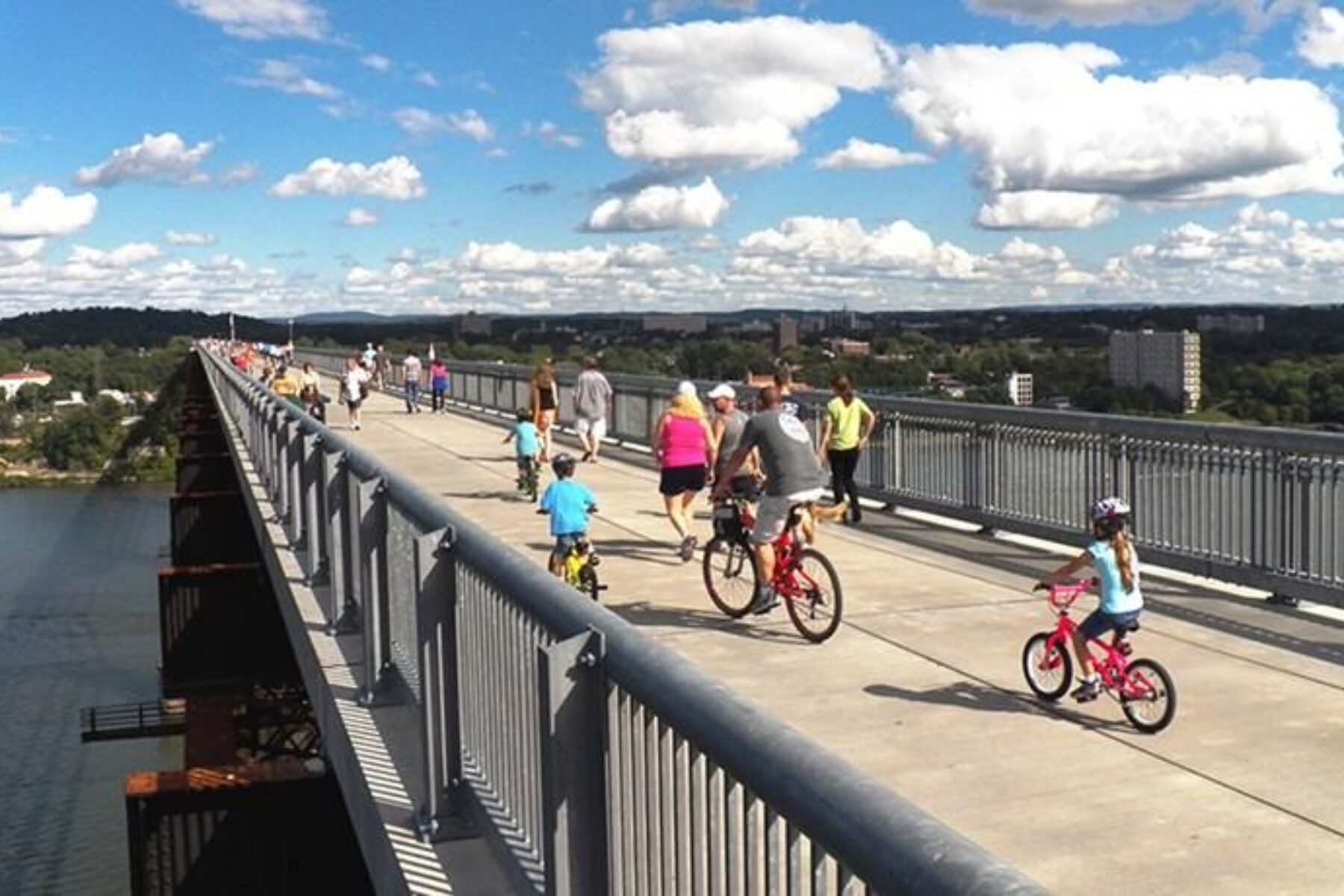
Trail of the Month: March 2016
“The Walkway, when it opened, was just an unparalleled success. It instantly became a beloved community asset.”
The morning wind playfully tousles Fred Schaeffer’s hair as he stands in quiet wonder on the Walkway Over the Hudson—something he’s done for nearly a decade of mornings since the trail opened. The view looking out over the inky waters of the river more than 200 feet below and the sleepy hillsides awakening against a softly brightening sky is one he never tires of. The enchanting setting is fitting for something once deemed impossible.
“In the beginning, everybody was skeptical,” says Schaeffer, who helped spearhead the Walkway’s transformation from a derelict railroad bridge into a sky-high public park. “So we started taking people out there, and once you took them out, they became believers.”
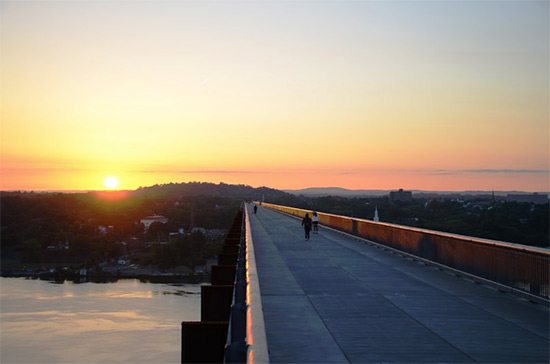
The Walkway—the longest pedestrian bridge in the world—emerges out of the trees and over the rooftops of the old riverfront town of Poughkeepsie, crosses the vast Hudson River and touches down in the hamlet of Highland on the other side, traveling just shy of a mile and a half all told. Rail-trails join the Walkway and spin out into the hillsides in either direction: the Hudson Valley Rail Trail on the west bank and Dutchess Rail Trail to the east. Together, they form a seamless 18-mile paved pathway capturing the beauty of New York’s Hudson Valley, a lush sanctuary between the bustling metropolis of New York City and the state capital of Albany.
Short Trail, Big Impact
For Schaeffer, a chance meeting in 1992 with Bill Sepe, a Poughkeepsie resident and early advocate for the project, changed the course of his life. “He took me up there and I fell in love with it,” he says. “The view is breathtaking.”
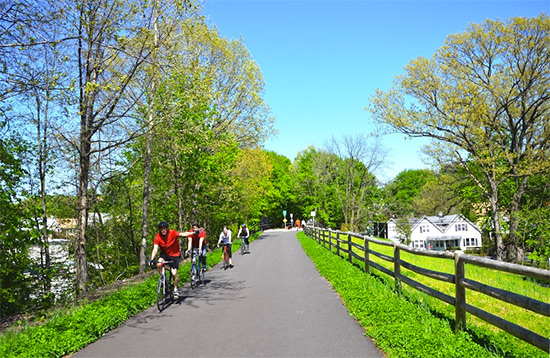
Sepe founded a nonprofit organization for the trail, and word began slowly spreading. Schaeffer, an attorney and avid bicyclist, was an astute pitchman for the project, presenting the idea to more than a hundred local groups and drumming up publicity in the media. “Don’t look down” was the mantra as potential supporters were taken onto the bridge to envision its future. Steel grates had been placed between the ties for safety, but you could see through them to the river far below. (Today, huge concrete slabs lay atop the steel beams.)
Schaeffer was elected chairman of the Walkway Over the Hudson in 2004, and what began as a quiet ripple became a wave when the project secured $1.5 million from the Dyson Foundation three years later, as well as additional funding from federal and state sources. In a press release announcing the grant, the company’s president, Robert R. Dyson, likened the project to San Francisco’s iconic Golden Gate Bridge for its historical significance and visual appeal.
“Once we got money for the concept plan, we had a public meeting in Poughkeepsie,” says Karl Beard, New York projects director for the Rivers and Trails Program of the National Parks Service. “It was surreal. There were hundreds of people standing in the hotel lobby because the room was overflowing. It was way more people than we expected. The enthusiasm for this was far greater than anybody imagined.”
A comprehensive inspection of the bridge took place in 2007, finding that the massive steel structure and its underwater piers were still sound. From there, construction in order to ready the bridge for the public went relatively quick, coming to completion in 18 months. Spurring its development was the upcoming 400th anniversary of Henry Hudson’s historic 1609 journey up the river. The state was looking for a large-scale project to commemorate the occasion and chose the Walkway as a signature endeavor.
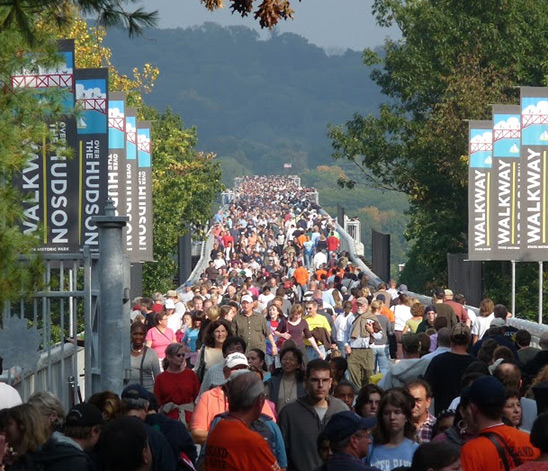
“That first weekend, 40,000 people came,” says Schaeffer of the trail’s opening in 2009. “Nobody had any idea there would be that many. I had nightmares that I would have to call people to get them to come out.”
The number of visitors that first year far exceeded expectations, and an average of 500,000 people continue to visit the bridge annually.
“The Walkway, when it opened, was just an unparalleled success,” says Chris White, deputy director of planning for Ulster County. “It instantly became a beloved community asset. What the experience of that really made clear is that with these types of facilities, when you build them, people come.”
The Green Miles
On the eastern side of the bridge, the development of the Dutchess Rail Trail, which had been moving at a slower pace, began to quicken in tune with the Walkway.
“The trail was built in phases,” says Colleen Pillus, communications director for the Dutchess executive’s office. “There was a groundbreaking and opening [celebration] for each phase, and each one was larger than the last. The crowds have gotten bigger and the enthusiasm louder.”
Finished in 2013, the trail—officially named the William R. Steinhaus Dutchess Rail Trail after the county executive who championed it—spans 13 miles through a handful of rural communities and rolling countryside. One of its unique aspects is its Veterans Memorial Mile, which features signage honoring each of the five branches of the military along a wooded section of the trail chosen as a quiet place to reflect and remember those who have served.
“Poughkeepsie is one of those Upstate New York cities that’s growing and vibrant,” says Dutchess Executive Marc Molinaro of the trail’s beginning. “Then you feel like you’re off in the Adirondacks. The trail offers a remarkable view of the county. At each trailhead, there’s a reason to stop.”
At trail’s end, the Hopewell Depot, built in 1873 and once serving as a busy railroad hub, offers a museum and historical photo gallery inside. The building was nearly lost in a 1986 fire but restored by a corps of local volunteers.
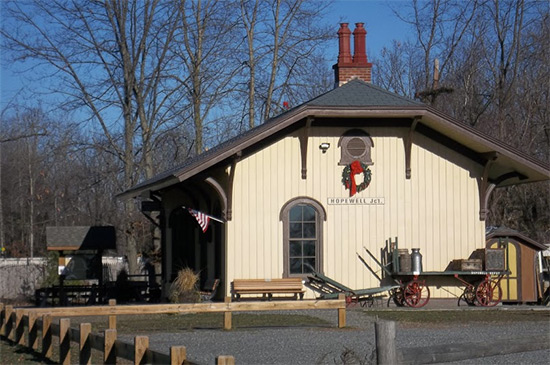
“Hopewell Depot was in disrepair for quite some time,” says Pillus. “The construction of the rail-trail propelled its restoration. When I saw it, I thought, ‘That can’t be repaired—there’s no roof!’ But as the trail generated new interest and new fundraising opportunities, the depot came back to life.”
On the other side of the Hudson, two cabooses—one dating back to 1915 and the other to 1926—also showcase the region’s rail history along the Hudson Valley Rail Trail.
Back in the mid-2000s, at a community meeting to envision that trail, Beard advised against making it dead straight; instead he suggested that trail advocates vary the pathway to make it more interesting. Ray Constantino, a longtime member of the local Rotary Club, who was leading the project, took the feedback to heart, and today, each sweep of the trail’s serpentine curves now offers a picturesque surprise.
“There are cool spots in the heat of the summer,” says Constantino of the Hudson Valley Rail Trail, which is lined with hardwood forests for much of its nearly 4-mile length between the Walkway and the town of Lloyd. “You’re walking down this shaded corridor with a canopy of trees on top of the rock cuts, so it’s a big tunnel of trees that is cool and damp, and you see all these little wildflowers growing in all the crevices of the rocks.”
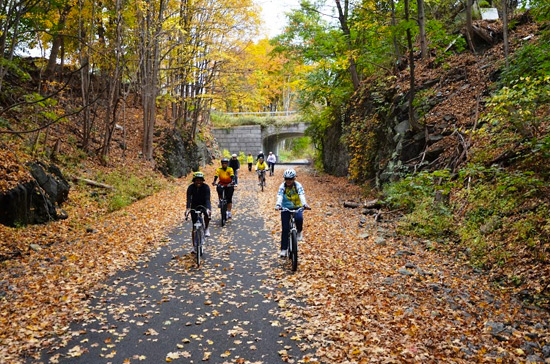
Arched stone bridges carry the roadways overhead, while beneath them, travelers are immersed in a world both serene and green with only the gentle whirring of bikes or soft footsteps on the blacktop. As the trail approaches its western end, it crosses the Black Creek Preserve, a beautiful marshland and wildlife haven. Although the pathway currently ends at Tony Williams Park, two future phases of the trail are in the works to bring it just a couple of miles farther west to the college town of New Paltz and a connection with the 21-mile Wallkill Valley Rail Trail.
“Any time day or night, there’s a whole gamut of different users,” says Constantino proudly. “Never did I envision that there would be so much use on the trail. My wife and I will sit on a trail bench, look at each other, and just smile and say, ‘Wow! Look at this! It’s crazy.’”
The Great Connector
When it first opened in 1888, the railroad bridge that is now the Walkway was hailed as the Great Connector, as it offered a vital link between New England cities and supplies from Pennsylvania, the Midwest and farther afield. Now the bridge is once again reprising that role in a new way, serving as a catalyst for a rail-trail network that may one day stretch from New York City all the way to the Catskill Mountains.
“A hallmark of Michael Hein’s administration is to focus on rail-trail development,” says White of the current executive for Ulster County. “We have a commitment of approximately $12 million for four active trail projects that are well into design or launching into design this spring. With the Walkway, other pieces of the regional trail system started to fall into place. By connecting these trails in such an extraordinary way, it raised the bar for everyone. It captured the imagination of elected leaders, civic groups and the state. It’s an exciting time for trails.”
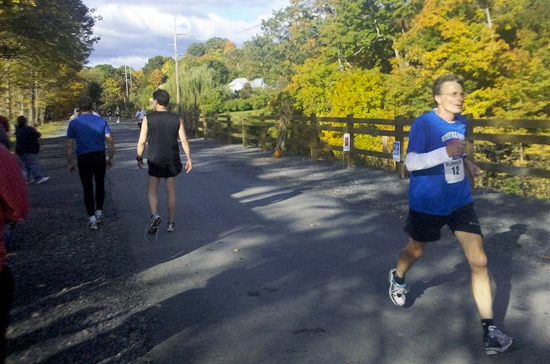
At a press event for the Walkway in the mid-2000s, Beard recalls “When [the reporters] asked me, ‘What’s your perspective?’ I said, ‘Well, if you look at a map of trails in this area—if you draw lines of existing and potential trails—it looks like a big floppy bow tie, and the Walkway is the knot in the bow tie. It’s a destination in its own right and the destination that all these other trails strive to connect with to tie them all together.”
It’s an idea the resonates with White: “With every gap that we fill, our efforts spur more projects and make people think even bigger. It’s a good time to be an outdoor enthusiast in the region.”

Donate
Everyone deserves access to safe ways to walk, bike, and be active outdoors.
